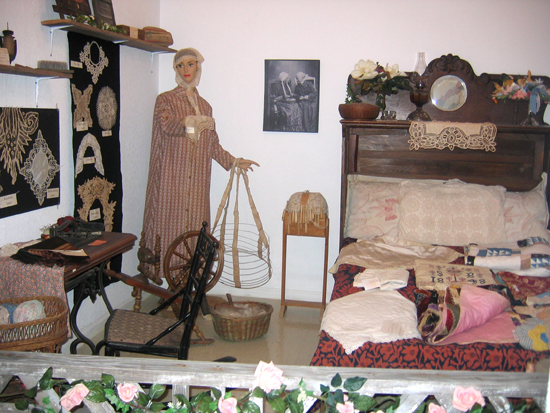For nearly a mile down the dirt road on which the museum sits, you can see the large white columns and striking red brick of the Bates County Historical Society of Butler, Missouri.
This colonial style two-story sits on a massive lot with relatively few other buildings surrounding it, making the museum’s mansion-like exterior even more eye-catching.
Once inside, your attention is immediately drawn to the immense wooden staircase that leads to the many exhibits housed on the second story. Long before you reach that staircase, however, Peggy Buhr, the museum’s director, will undoubtedly greet you with a warm welcome and shower you with her enthusiasm for the museum and the history of Bates County.
During the day that I spent in her company, Buhr generously shared the successes and struggles that accompany running a local museum. Her experiences offer a personal account of what it requires to preserve the history of a region that was torn by war and forced to contend with the conflict’s lasting legacy in distinctive ways.
A native of the area, Buhr was born “across the line” in Vernon County but spent most of her life in Southern Bates County. When I asked her how she developed her love for American history, she described a Civil War reenactment in Lone Jack that sparked her interest.
“I was hooked and immediately joined their historical society.” Buhr says. “Over the course of the next three years, I delved into my own family’s Civil War history, got more involved in Lone Jack, and met many other history-minded people through the Border War network.”
In 2007 her tireless volunteer work – and marketing background – paid off when she was offered the position of museum director at Bates County. Since then she’s funneled most of her energy into the museum with an ever-present sense of good humor and patience.
Admittedly, the challenges of running a small museum are many, though Buhr would tell you that’s what keeps the job interesting.
“Every day unfolds in fun, exciting, and sometimes frustrating ways, but I never allow myself to become discouraged or overwhelmed,” Buhr says. “The upside is that I never get bored!”
With several exhibits, an ever-growing archival collection (an item was even donated during my visit), and a busy banquet hall rented out for events of all kinds, Buhr would gladly tell you that she “wears many hats” at the museum – whether it be director, event planner, museum curator, archivist, or an entirely new role created on the fly.

A display of Civil War women's crafts at the Bates County Museum.
Aside from benefiting from the many stories of the museum, I was also afforded the opportunity to view some of museum’s collections from the Civil War-era. As we combed through the delicate and yellowed paper of loyalty oaths and handwritten letters, one item, in particular, ignited our interest.
The diary of Abram Lewis, a Confederate soldier who served under Sterling Price, offered that rare chance to examine some of the War’s milestones through the eyes and experiences of an individual soldier. His regional identity informed his choice to fight with the Confederacy, yet, at the close of the War, he sacrificed that identity in order to return to his family and his home. The diary teems with his thoughts, observations, and lamentations as he wrote of the men he met, the travels he undertook, and the illness and death that he encountered.
“The diary brings to life the confusion and complexity of the War,” Buhr says. “He was a man of peace torn by what was truly right or wrong.”
By shedding light on the stories of those who experienced the Civil War firsthand and those who are responsible for preserving that history in the present day, we are able to obtain a broader perspective on the ways in which those four years in the 1860s transformed (and continue to impact) our region.
Beyond solely Civil War history, Buhr will tell you the importance of keeping all of our shared stories alive and the impact that preservation can have on a community. For example, at a recent event to honor the Vietnam Veterans of Bates County, Buhr says she received an outpouring of gratitude for those who attended.
“It was one of the most memorable experiences of my life and I shall never forget how proud I was that the museum was able to pay tribute and honor them in such a fitting way,” Buhr says.
The dedication and enthusiasm of the many museum directors like Peggy Buhr that I’ve met over the past six months demonstrates the importance of projects like the Missouri-Kansas Conflict. These projects seek to unite and share our stories with a national audience.
About the Author

Hannah Ballard was the Project Coordinator for the Missouri-Kansas Conflict: Civil War on the Western Border. She earned her B.A. degree in American history from the University of Kansas with a special focus on nineteenth-century Kansas.
